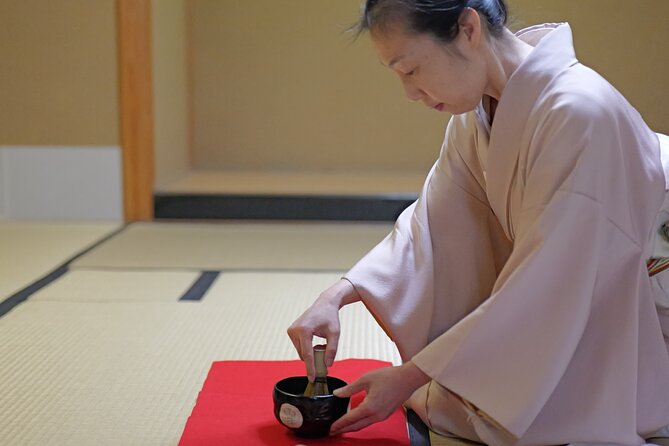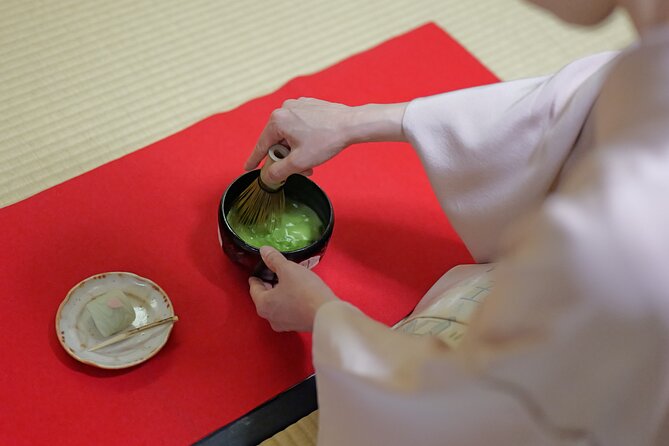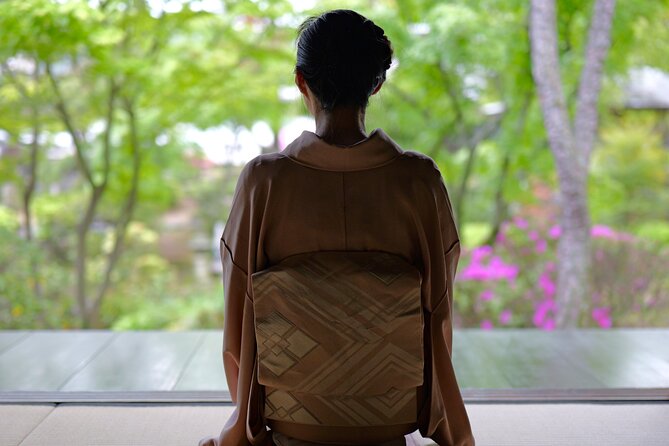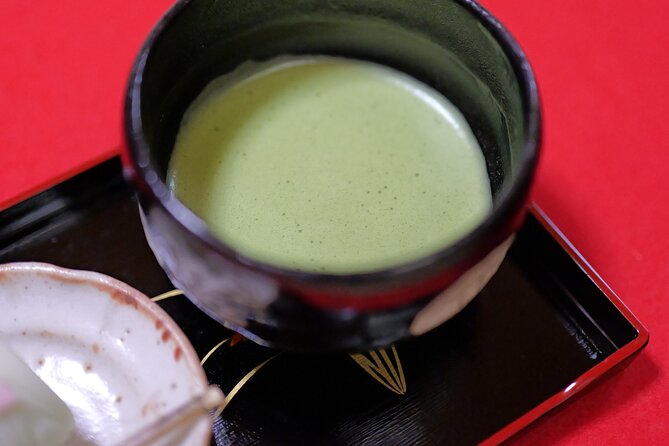In the heart of the Kurashiki Bikan Historical Quarter, the Tea Ceremony stands as a tranquil oasis, much like a delicate cherry blossom floating in a serene pond. As visitors step into this timeless ritual, they are transported to a world where every gesture holds deep meaning.
The graceful choreography of pouring and sipping tea, the hushed reverence for tradition – all culminate in an experience that transcends mere observation. For those seeking a harmonious blend of history and mindfulness, the Tea Ceremony in Kurashiki Bikan beckons with promises of cultural immersion and understated elegance.
Key Takeaways

- Immerse in centuries-old tea tradition embodying harmony and tranquility.
- Experience artistry and mindfulness in a moment of reflection.
- Learn proper etiquette and access necessary tools for a full tea ceremony.
- Enjoy an intimate setting with expert instructors for a cultural exchange.
Overview of Tea Ceremony Experience

When experiencing the Tea Ceremony in Kurashiki Bikan Historical Quarter, participants can immerse themselves in the tranquil traditions of Japanese tea culture. This cultural immersion offers a unique opportunity to partake in a traditional practice that dates back centuries.
The ceremony embodies harmony, respect, purity, and tranquility, providing a window into the essence of Japanese customs. Through the meticulous gestures of the tea master and the serene atmosphere of the tearoom, guests can witness firsthand the artistry and mindfulness behind every movement.
Engaging in this ritual not only educates individuals about Japanese heritage but also allows for a moment of reflection and calmness in the midst of a bustling world.
Meeting Point and Directions
For participants in the Tea Ceremony in Kurashiki Bikan Historical Quarter, the meeting point is Keiken-do located at 1-1-20 Chuo, Kurashiki, Okayama 710-0046, Japan. To reach the venue, visitors should exit Kurashiki Station and walk southeast on Kurashiki Ekimae-dori street for approximately 10 minutes.
Here are some meeting logistics and travel tips to ensure a smooth experience:
- Arrive at least 15 minutes early to check-in and get acquainted with the surroundings.
- Consider wearing comfortable footwear for the short walk from the station to Keiken-do.
- Bring a bottle of water to stay hydrated during the ceremony.
- Check the weather forecast beforehand and dress accordingly for any outdoor walking.
- It’s recommended to have a map or GPS handy in case you need assistance navigating the area.
Inclusions and Exclusions

To understand what’s covered in the Tea Ceremony in Kurashiki Bikan Historical Quarter, it’s important to know the inclusions and exclusions provided by TAKAHASHIGAWA TRAVEL.
The inclusions encompass the full experience of the traditional Japanese tea ceremony, including guidance on proper etiquette and the chance to partake in time-honored tea traditions. Participants will also have access to all necessary materials and tools for the ceremony.
However, it’s essential to note that certain exclusions apply. These may involve personal purchases of tea-related items or any additional services not explicitly mentioned in the package. Understanding these inclusions and exclusions will ensure a smooth and enriching tea ceremony experience, allowing guests to fully immerse themselves in the beauty of Japanese tea culture.
Group Size and Accessibility

Group size for the Tea Ceremony in Kurashiki Bikan Historical Quarter is limited to a maximum of 15 travelers. When considering accessibility and inclusivity for this cultural immersion experience, it’s crucial to note the following:
-
Intimate Setting: Limited group size allows for a more personal and authentic interaction during the ceremony.
-
Inclusivity: Smaller groups ensure that everyone can actively participate and engage with the tea ceremony practices.
-
Cultural Immersion: The small group size enhances the quality of cultural exchange and learning opportunities.
-
Ease of Movement: With a maximum of 15 travelers, navigating the venue becomes more manageable for all participants.
-
Enhanced Experience: The intimate setting fosters a deeper connection with the tea ceremony traditions, enriching the overall experience.
Confirmation and Itinerary Details

Upon booking the Tea Ceremony in Kurashiki Bikan Historical Quarter, travelers can expect to receive a confirmation along with detailed itinerary information. The confirmation details will typically outline the date, time, and meeting point at Keiken-do in Kurashiki.
Additionally, the itinerary logistics will cover the flow of the tea ceremony experience, including the traditional rituals, duration of the ceremony, and any breaks or activities included. It’s advisable for participants to arrive at the meeting point on time to ensure a smooth start to the event.
Understanding the confirmation details and itinerary logistics beforehand can help travelers prepare adequately for this cultural experience in the picturesque Kurashiki Bikan Historical Quarter.
Operator Information

When booking the Tea Ceremony in Kurashiki Bikan Historical Quarter, travelers will engage with the experience operated by TAKAHASHIGAWA TRAVEL for a seamless and authentic cultural immersion. Here are some operator details to enhance your cultural experience:
- TAKAHASHIGAWA TRAVEL ensures a well-organized and traditional tea ceremony.
- Expert tea ceremony instructors guide participants through each step of the ritual.
- The operator offers insights into the history and significance of the tea ceremony in Japanese culture.
- TAKAHASHIGAWA TRAVEL provides a welcoming and hospitable environment for all participants.
- Travelers can interact with local hosts to gain a deeper understanding of Japanese customs and traditions during the ceremony.
What to Expect During the Ceremony

Participants will engage in a traditional tea ceremony led by expert instructors during the experience in Kurashiki Bikan Historical Quarter. The ceremony rituals will include precise movements, etiquette, and the preparation of matcha tea. Guests can expect to learn about the history and cultural significance of the ceremony.
Tea tasting techniques will be demonstrated, allowing participants to appreciate the flavors and aromas of the specially prepared tea. Throughout the ceremony, there will be opportunities to ask questions and interact with the instructors. The atmosphere will be serene and focused, creating a tranquil environment for guests to immerse themselves in this ancient Japanese tradition.
This experience offers a unique insight into the art of tea preparation and consumption.
Conclusion and Return to Meeting Point
As the tea ceremony in the Kurashiki Bikan Historical Quarter draws to a close, participants will be guided back to the meeting point at Keiken-do for the conclusion of the experience. Upon returning to the meeting point, attendees can expect the following:
-
Reflection Time: Take a moment to reflect on the tea ceremony experience.
-
Gift Exchange: Receive a small token to remember the ceremony.
-
Farewell Remarks: Listen to closing remarks from the tea ceremony host.
-
Group Photo Opportunity: Capture a memorable group photo to cherish.
-
Final Q&A: Ask any remaining questions about the ceremony.
These elements will wrap up the tea ceremony before participants depart from Keiken-do.
Frequently Asked Questions
Can Participants Wear Traditional Japanese Attire During the Tea Ceremony?
Participants can wear traditional Japanese attire during the tea ceremony for an enhanced cultural experience. This provides an authentic touch to the event. It adds to the ambiance and allows individuals to fully immerse themselves in the ceremony.
Is There a Specific Etiquette That Participants Should Follow During the Tea Ceremony?
Traditional tea ceremonies in Japan have specific etiquette guidelines. Participants should follow cultural customs like bowing, silence, and proper handling of utensils. Respecting the tea master and the ritual is crucial. Learning these customs enhances the experience and shows appreciation.
Are There Any Specific Dietary Restrictions or Preferences That Can Be Accommodated During the Tea Ceremony?
For participants with dietary needs, vegetarian options are available. Any allergies can be accommodated during the tea ceremony. The experience ensures everyone can enjoy the traditional Japanese ritual without restrictions, making it inclusive for all.
Will There Be English-Speaking Guides or Translators Available During the Tea Ceremony?
English speaking guides are available to enhance the cultural experience during the tea ceremony. Participants can engage fully and understand the traditions and rituals with the guidance provided. This service adds value to the event.
Are There Any Age Restrictions for Participating in the Tea Ceremony?
There are no specific age restrictions for participating in the tea ceremony. However, guests are encouraged to wear appropriate attire. This activity is inclusive and does not impose strict age limitations, ensuring a welcoming experience for all.
Conclusion
Immerse yourself in Japan’s rich tea culture with a Tea Ceremony in Kurashiki Bikan Historical Quarter. Hosted by TAKAHASHIGAWA TRAVEL, this intimate experience offers a glimpse into the elegant art of tea preparation.
With a maximum of 15 participants, enjoy a serene setting and exclusive insight into Japanese customs. Book now for a memorable cultural encounter in Kurashiki.
